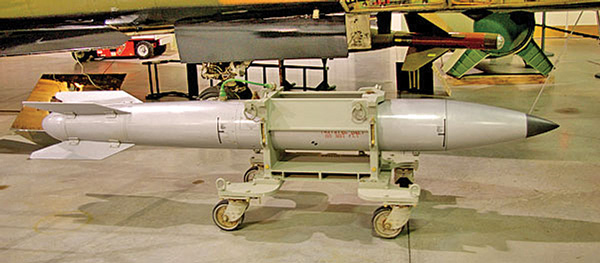News & Articles
Browse all content by date.

With 180 US nuclear weapons spread among five or six NATO allies, an explosive cocktail of military instability mixed with 11-foot long US nuclear bombs raises the specter of accidental or suicidal detonation in or near Turkey. This risk was brought into extreme relief by the attempted military coup there in mid-July.
In June I warned in these pages and in CounterPunch magazine that the Pentagon’s 50 to 90 B61 thermonuclear gravity bombs deployed at Incirlik Air Force Base in Turkey are too dangerous and vulnerable to keep so close to a warzone. I don’t believe journalists with the Los Angeles Times, the Japan Times, the Washington Post, Foreign Policy magazine or the San Antonio Express News read my columns, but suddenly US nuclear bombs in Turkey are a hot topic.
Tobin Harshaw reported for Bloomberg July 25 -- although he mischaracterized the bombs -- “Until recently, the question of whether the United States should continue to station nuclear missiles [sic] in Turkey was of interest only to a passel of national-security geeks and nonproliferation advocates. One failed coup later, the discussion has spread to CNN, The New Yorker, the New York Times, The Washington Post and elsewhere.”
Harshaw went on to validate analyses by Eric Schlosser, author of the nuclear accidents history “Command and Control” (Penguin 2013), and Jeffrey Lewis of the Middlebury Institute of Int’l Studies, who argue that “Turkey is not a sensible base for nuclear deterrence.” But in the irrational, self-contradictory realm of nuclear war planning, the B61s are being stored at Incirlik because military hawks insist on “maintaining the capability to attack Iran” with H-bombs, Harshaw reported. Never mind that Russia and Pakistan would doubtless retaliate with their nuclear warheads if the US used its against Iran.
The reasons why our military’s so-called “forward deployment” of the B61s amounts to nuclear madness were only highlighted by the bloody, hapless coup d’état inside Turkey:
1) The Los Angeles Times reported July 23: “The base was an operational center of the attempted coup,” which, US military experts said, demonstrated “a worrying level of instability in Turkey’s military command close to the B61s.” Wikipedia lists 20 terrorist strikes inside Turkey since 9/11, and the Incirlik AFB is only 100 miles from Islamic State territory.
2) The B61s stored at Incirlik are designed for the McDonnell Douglas corporation’s long-range, high speed F-15E jet fighter and for Lockheed Martin’s F-16 jet fighter. But none of these planes are based at Incirlik or in the Turkish Air Force. As the LA Times reported, “The US does not have aircraft at Incirlik qualified to deliver the weapons.” (“In order for the weapons to actually be used, the US would have to fly a squadron of aircraft into Incirlik to load the bombs, all of which would be observed by Russia and possibly make the base a target for a first strike,” the Times reported.)
3) The B61s are designed to prevent unauthorized use as they have safeguards known as “use controls” and “permissive action links.” But Robert Peurifoy, formerly of the Sandia National Laboratory where he, according to the LA Times, “designed the first use controls on weapons based in Europe,” said that the “use controls may only impede and delay a terrorist. … Either you keep custody or you should expect a mushroom cloud.”
4) General Eugene Habiger (USAF Ret.), a former commander of all Air Force and Navy strategic nuclear weapons (he led the Strategic Command from 1996 to 1998), told the San Antonio Express “the bombs no longer have any military usefulness.” And Gen. Habiger warned, “It’s a very, very dangerous weapon in terms of military consequences, political consequences, and I think what happened in Turkey highlights the potential unintended consequences of having nuclear weapons forward deployed if there is no military requirement.”
5) The B61s will almost certainly never be used, according to Aaron Stein, a Turkey analyst at the Atlantic Council, who spoke to the LA Times. This common knowledge moved Gen. Habiger to ask, “Why does NATO need nuclear weapons?”
Why indeed. And because, as Jeffrey Lewis noted in Foreign Policy online June 18, “after the events of the past weekend, leaving them in place seems positively terrifying,” wild Turkey becomes that latest and best reason ever to permanently remove US nuclear weapons from NATO.
How powerful is the B61 gravity bomb?
• Bloomberg News says the B61 is a “variable-yield” device, meaning the size of the explosion can be between .3 kilotons [300 tons] and 340 kilotons of TNT equivalent.
• The Los Angeles Times reported that it can be programed to have between 300 tons of TNT explosive force, and 170,000 tons [170 kilotons]
• Nuclear weapons analyst John Pike with www.globalsecurity.org, says “yields range from “a few hundred tons to 160 kilotons.”
To compare: the US Army Air Corp’s Hiroshima bomb, which killed 140,000 people, was a 15 kiloton bomb.
| Tweet |

